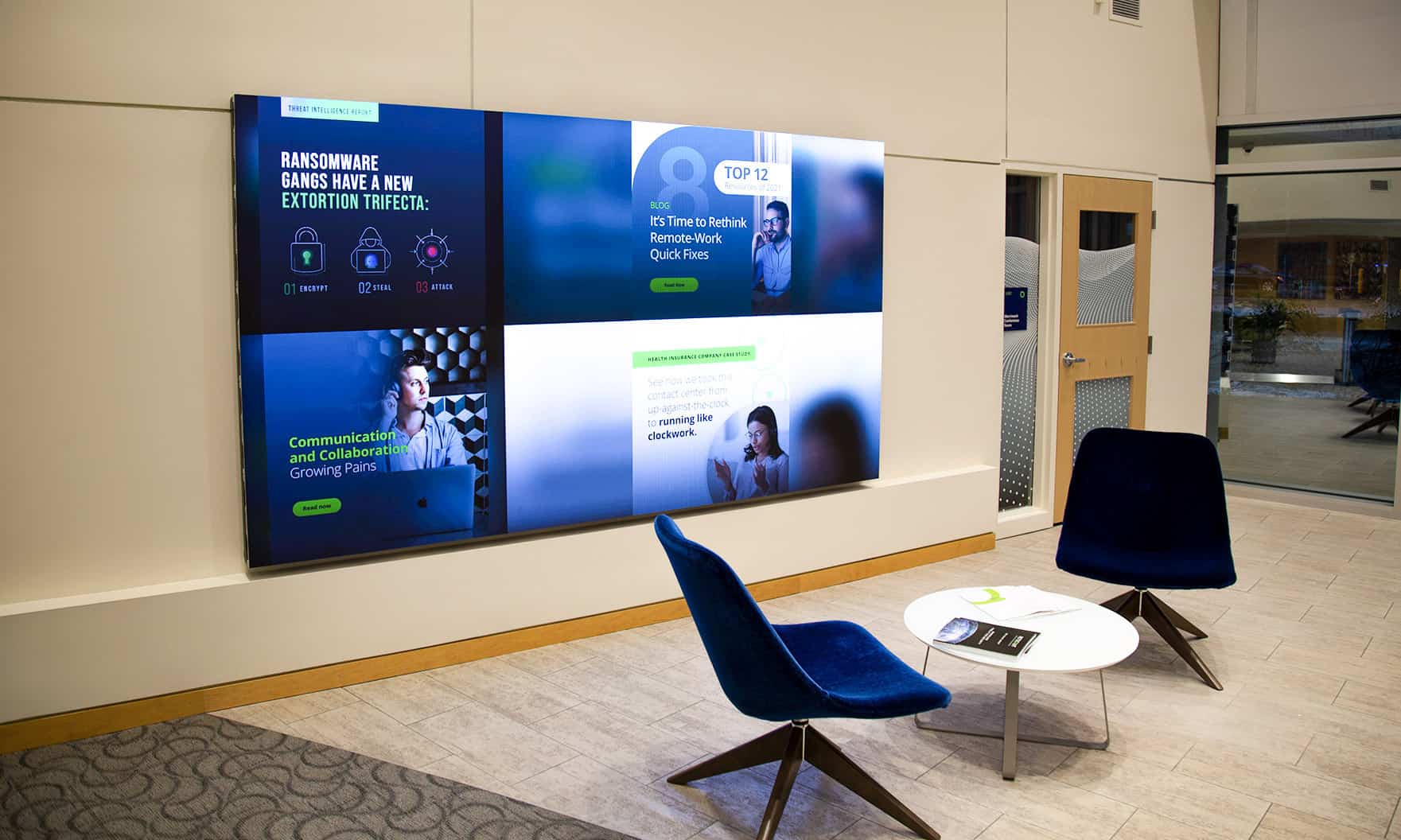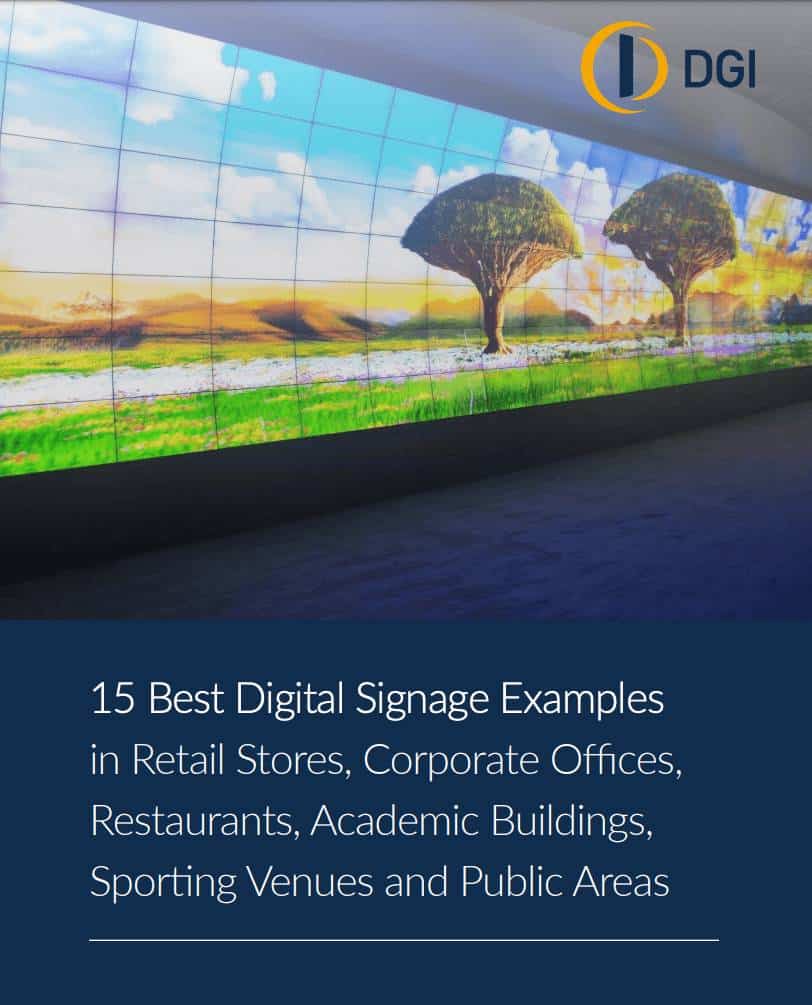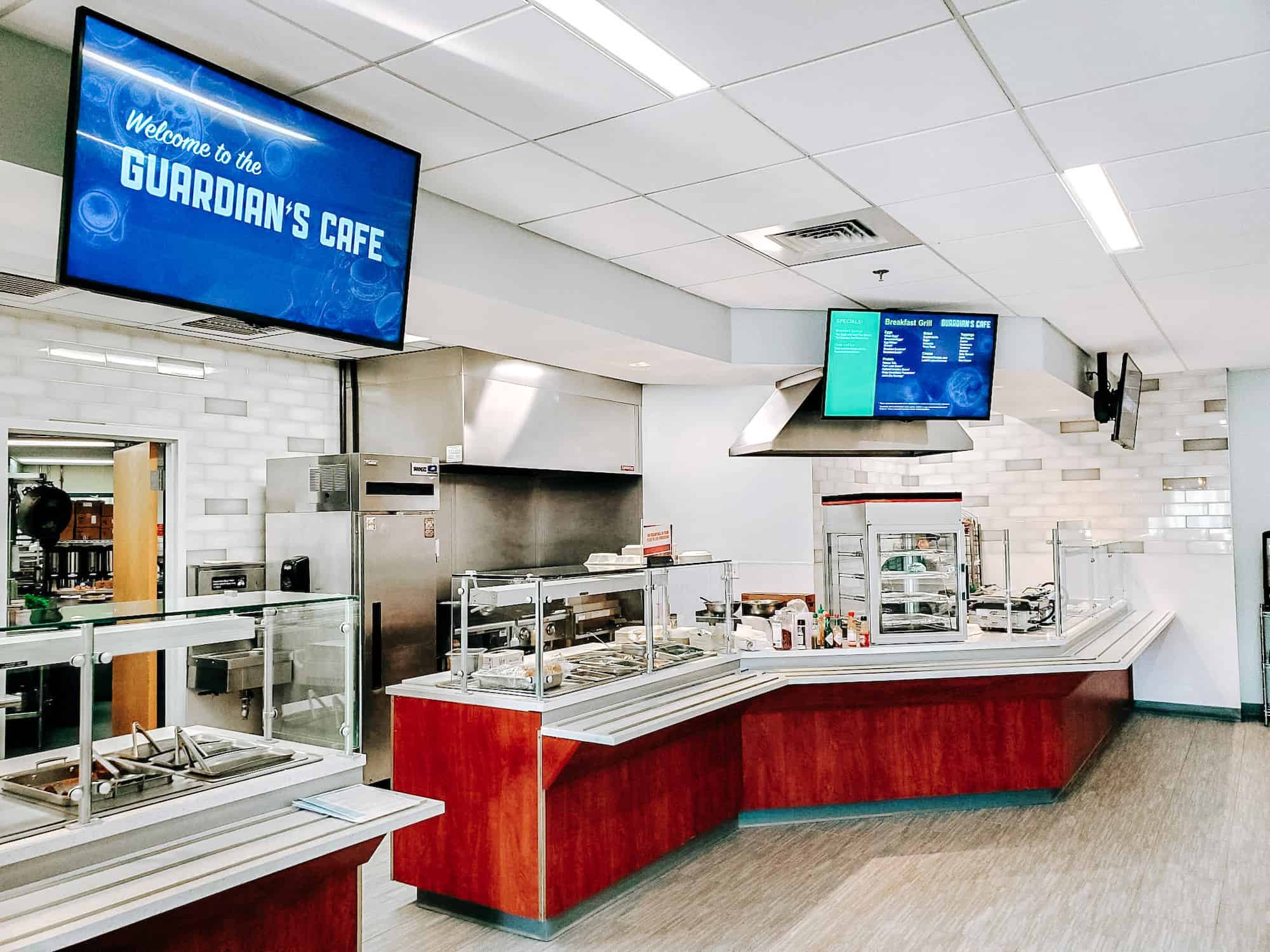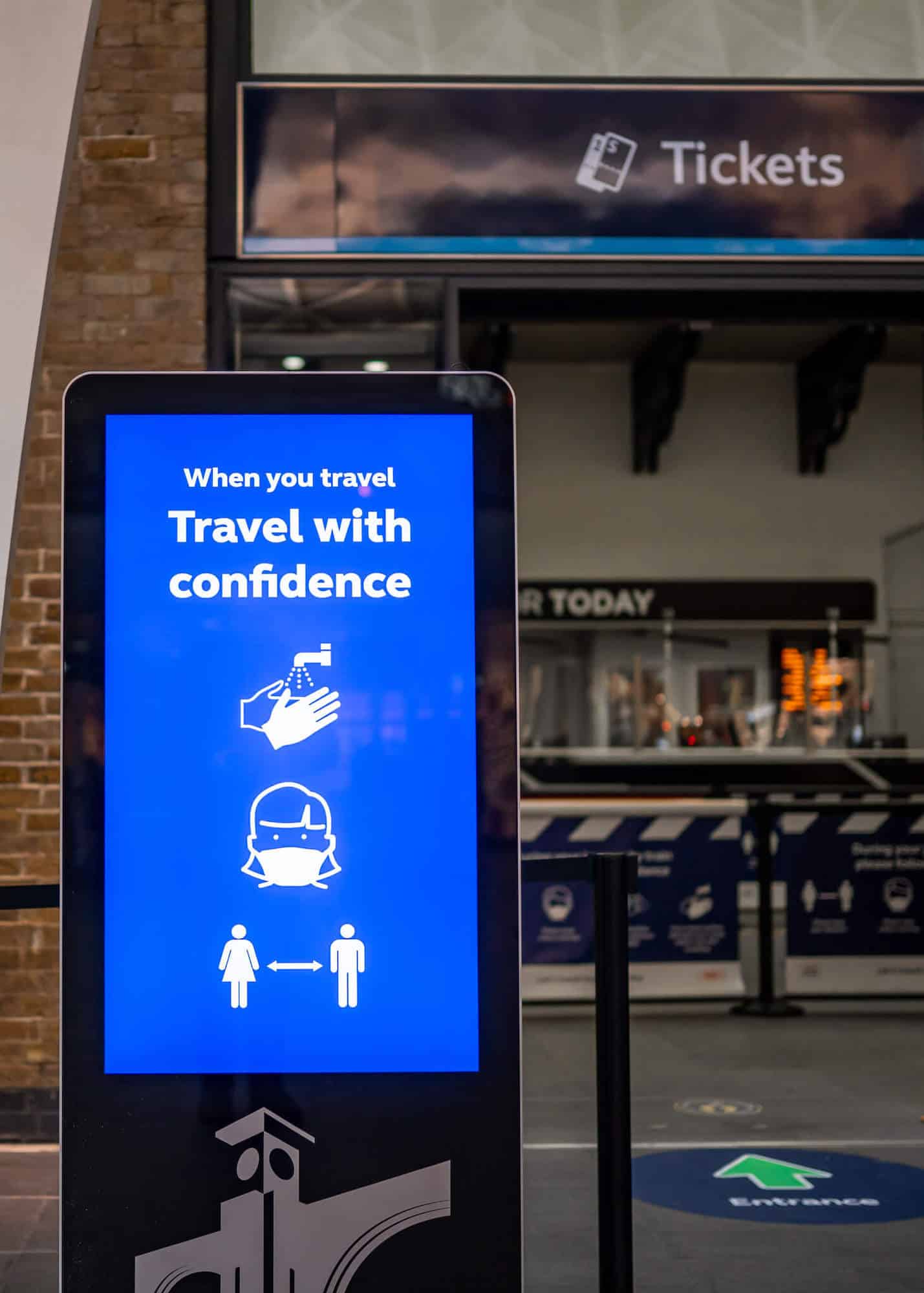Digital signage allows you to display information in a variety of locations and manners. It’s an affordable and easy-to-use way to share your organization’s message, branding, and marketing efforts with those in a targeted area. An LED display with a map of your favorite shopping mall is a perfect example of wayfinding digital signage, and the computer monitor-sized screens that display menu items at your local sub-shop are great informational displays.
Digital signage can be found outdoors as well. Look no further than the billboards posted along major highways and at city street corners all over the United States or the jumbotron at your favorite sporting event. It’s safe to say digital signage informs and entertains us nearly everywhere we go.
From informative screens in corporate lobbies to mouth-watering menu boards in fast-food chains, digital signage examples are all around us, and they’ve proven a powerful tool in capturing attention, conveying information, and influencing decision-making.
Digital signage can be a range of things, including:
Informational: Customers wanting to get information at restaurants, stores, and other places of business are increasingly interacting with digital screens as part of that process. Public safety alerts are a civic-oriented form of information that can also be disseminated through digital signage.
Directional: Digital wayfinding signage is fast replacing printed signs as the go-to medium of choice for large office buildings, medical facilities, and transportation systems looking to display lists of suites, floorplans, or transportation maps and schedules. These systems are brighter as well as easier to read and update, should one be required.
Interactive: Certain digital displays respond to user touch or other forms of input. That shopping mall display we mentioned earlier might have touch sensitivity built into it. If it does, users will be able to select the store they would like to visit with the push of a finger and then get detailed directions on how to get there.
Tips and Strategies to Maximize Your Digital Signage’s Impact
Engage Your Audience
In the realm of digital signage, content is king. Engaging content captures attention, communicates messages effectively, and encourages viewer interaction. To create captivating content, keep it concise, clear, and relevant. Use powerful headlines, compelling visuals, and clear calls to action. Remember, your digital signage should tell a story, just like the digital signage examples in this article.
Use Appropriate Font Type, Size & Style
If digital signage is unreadable, no one is going to get the message. Choose a readable font size and type. Sans serifs fonts are great options as they are typically easier to make out. Depending on the size of your display, bold text and large lettering might be called for as they are clearer from a distance.
Ensure Consistent Branding
Consistent branding is crucial for effective digital signage. Your color scheme, typography, imagery and tone should align with your brand identity. Doing this enhances brand recognition while simultaneously building trust with your audience through repetition.
Color and Contrast
Contrast is the primary requirement for legibility in digital signage. There should be high contrast between the background color and the text shade to maintain readability. Your logo and brand kit will inform your color palette; make sure they include both light and dark shades that work well on screens if you plan to take advantage of digital media.
Consider the Context
Like in many areas of life, in digital signage context is key. On billboards and other out-of-home advertisements, for example, bold, bright colors and imagery strategically grab the attention of passersby. Alternatively, in libraries or medical facilities, soothing colors and imagery are more appropriate.
Use Eye-Level Placement
Place the content on your signage to align with the reader’s eye level. Most people read from left to right, but if people in your region prefer to read from right to left, place your content accordingly. The most critical content should be featured in the center of your display with other areas used for supporting information.
Use Animation
Moving content such as animations and videos make your digital signage more immersive, eye-catching and effective. With many people preferring visuals to reading static text, there is a distinct engagement edge associated with moving content that can’t be denied.
Timing Matters
The target runtime of the content you show on digital signage is largely location-dependent. In a waiting room, the content you display should be anywhere from 30 seconds to 10 minutes long. On busy roads or in shopping malls, content duration should be no longer than the time it takes to drive or walk by.
Resolution
Display resolution is a critical factor when developing content for digital signage. It determines the clarity and precision with which your content will be displayed, the quality of your images and videos, the overall appearance of your signage, and the readability of your messages from a distance. Pictures and videos should typically be 1920 x 1080, full HD, for optimal results. By choosing a high-resolution display, you can ensure that your digital signage is clear, impactful, and engaging. Reinforcing your brand identity while maximizing the effectiveness of your messaging at the same time.
6 Impactful Digital Signage Examples
Retail Digital Signage
Retail digital signage takes customer interaction to a new level. From promoting deals to showcasing new arrivals, these dynamic displays captivate shoppers, creating an immersive experience. A real-world retail digital signage example can be found in Zara’s flagship store in London, which uses interactive screens for a seamless blend of online and in-store shopping. This use led to enhanced customer engagement and increased sales, proving the effectiveness of retail digital signage.
Corporate Digital Signage
Corporate digital signage is a game-changer for internal communications. It streamlines information sharing, from company updates to employee recognition, fostering a well-informed and engaged workforce. A standout among digital signage examples is Microsoft’s use of dynamic displays in their headquarters. These screens showcase real-time data, employee achievements, and corporate news. Fostering a culture of transparency and inclusivity. By using dynamic displays, Microsoft enhances employee engagement and productivity while fostering a sense of belonging. Corporate digital signage is a truly effective tool for building stronger, more connected organizations.
Restaurant Digital Signage
Restaurant digital signage enhances customers’ dining experiences by providing dynamic menu displays, promoting specials, and even entertaining patrons as they wait. Among the many examples of restaurant digital signage, McDonald’s use of digital menu boards to highlight meal deals and limited-time offerings truly stands out. These vibrant, easy-to-update displays allow for quick changes, accommodating fluctuating prices and sold-out items with ease. Improved customer service, increased upselling opportunities, and streamlined operations all resulted from this implementation, showing the undeniable effectiveness of restaurant digital signage in enhancing the customer experience and boosting sales.
Healthcare Digital Signage
Healthcare digital signage is transforming patient experiences and operational efficiency all across the industry. These dynamic displays provide wayfinding assistance, show wait times and share health education content with patients and staff. Mayo Clinic is a perfect example of this type of effective digital healthcare signage, employing screens for all of the functions listed above. Patients and visitors have since reported reduced stress and confusion, with improved operational efficiency for the clinic resulting as well, thus reaffirming that digital signage in healthcare is here to stay.
Education Digital Signage
Education digital signage is revolutionizing communication and engagement in schools and universities. These vibrant displays share event announcements, showcase student achievements, and broadcast emergency alerts. At the University of Waterloo, digital signs dispense campus news, event schedules, and wayfinding information. Leading to enhanced communication, increased student involvement, and a more connected campus community proving the efficacy of digital signage on campus.
Transportation Digital Signage
Transportation digital signage keeps travelers informed and operations running smoothly by providing real-time updates on delays, arrivals and departures and route maps. London’s Heathrow Airport is a stand-out example. Its signage system disseminates flight information, guides passengers through terminals, and even advertises local attractions. The result has been improved traveler experience, reduced confusion, and streamlined airport operations, demonstrating the pivotal role digital signage plays in enhancing communication and efficiency in high-traffic environments.
Conclusion
Effective digital signage can significantly improve communication, engagement, and efficiency in diverse sectors. For inspiration and advice to unlock more creative ideas, check out our digital signage inspiration eBook.
Engaging electronic signage stimulates interest, strengthens brand identity and generates profitable results. DGI’s team of AV professionals is ready to help create and install digital signage solutions for any organization.
Questions? Click here to get in touch.



